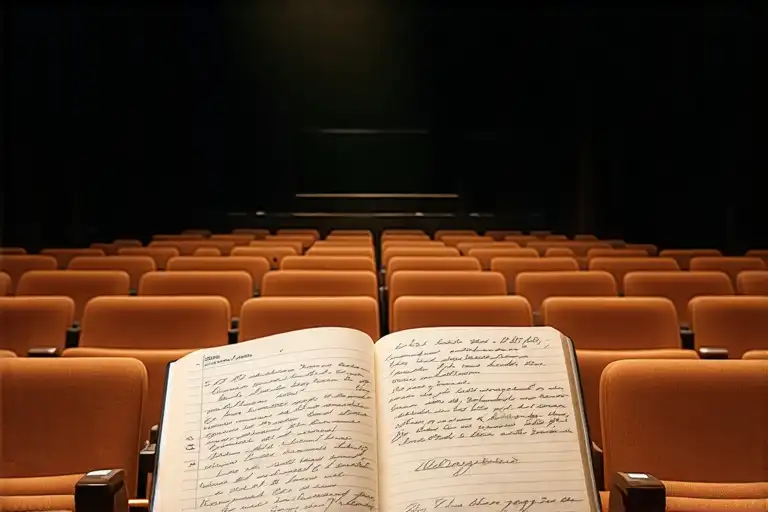The auditorium at Hamilton College buzzed with anticipation as former President Barack Obama took the stage, his signature grin breaking into laughter at the enthusiastic welcome. “Getting over my nerves here,” he joked, adjusting his microphone with the ease of someone who’s spent decades in the spotlight yet still finds joy in human connection. This April evening in 2025 wasn’t about political speeches or policy debates—it was something far more personal. A conversation between America’s first digital-era president and the next generation of leaders about navigating a world where AI reshapes careers, democracy feels fragile, and global cooperation seems more vital yet more elusive than ever.
Obama’s self-deprecating humor set the tone immediately. Recalling his early days as “one of the worst public speakers,” he transformed what could have been a lofty lecture into a masterclass in relatable leadership. “What made me better wasn’t magic—it was learning to listen to the stories of people in church basements and union halls,” he shared, leaning forward as if confiding in friends. The anecdote crystallized the evening’s central question: How do we lead effectively when technology accelerates change while human nature remains gloriously, frustratingly constant?
Behind the laughter lay urgent themes. When discussing his post-presidency work with the Obama Foundation, his voice took on new gravity. Training young leaders globally isn’t just philanthropy—it’s an antidote to what he called “the slow unraveling of democratic habits.” The room grew still as he described watching norms erode: universities pressured to silence dissent, law firms threatened for representing unpopular clients. “Imagine if I’d done that to Fox News,” he mused, drawing knowing chuckles before turning serious. “This isn’t about parties. It’s about whether we still believe in the idea that no one—not even a president—gets to rewrite the rules midgame.”
Technology threads through every challenge. Obama traced how social media evolved from Meetup’s face-to-face gatherings to today’s algorithmically amplified divisions. His warning about AI displacing 70% of coding jobs landed like a thunderclap, followed immediately by unexpected advice: “Unless you’re in the top 1% of coders, study liberal arts.” The rationale—that machines can’t replicate human storytelling, empathy, or moral reasoning—sparked vigorous applause from students suddenly reassured about their philosophy majors.
What emerged wasn’t a policy blueprint but something more valuable: a mindset for turbulent times. Obama acknowledged young people’s climate despair and political exhaustion, then countered with what might be his defining belief—that progress follows a “long arc” requiring stubborn hope. His closing image of Oval Office rug embroidery quoting Dr. King served as both metaphor and mandate: justice bends slowly because changing minds and systems is hard work, but bending it remains our shared responsibility. The standing ovation that followed felt less like routine courtesy than collective recognition—this wasn’t just a speech, but the passing of a baton.
From Awkward Speaker to Master Communicator
The journey to becoming an effective communicator is rarely linear. Even for someone who would later be known for his eloquence, Barack Obama’s early attempts at public speaking were far from perfect. “At least when I started as a politician and public speaker, I was often terrible,” Obama admits with characteristic humility during his conversation at Hamilton College. This candid confession serves as both reassurance and inspiration for young leaders grappling with their own communication challenges.
The Turning Point: Learning Through Failure
Obama’s early campaign speeches reveal a common pitfall many aspiring communicators face – over-reliance on facts and policies at the expense of human connection. “It was usually because I was filling my speeches up with facts and policies,” he recalls. These dry, data-heavy addresses failed to resonate, teaching him a valuable lesson: “That’s not how most of us get information. We get information from stories about our own experience, about other people’s experience.”
This realization marked the beginning of his transformation. The future president began consciously shifting from policy wonk to storyteller, understanding that emotional resonance precedes intellectual persuasion. His 2004 Democratic National Convention keynote address demonstrated this evolution, weaving personal narrative with national purpose in a way that catapulted him onto the national stage.
The Three Pillars of Effective Communication
Through trial and error, Obama distilled communication into three essential elements:
- Authentic Conviction: “The single most important thing about being an effective communicator is having conviction, believing what you say.” This foundational principle explains why some technically perfect speeches fall flat while imperfect but heartfelt messages resonate deeply.
- Relatable Language: “Talk like a normal human and not like a book.” Obama emphasizes using everyday language rather than formal or pretentious speech. He expresses puzzlement at speakers who adopt unnatural personas when addressing audiences.
- Active Listening: “If you’re a good communicator, you should also be a good listener.” This often-overlooked component became central to Obama’s approach. By truly hearing people’s stories, he learned to craft messages that addressed real concerns rather than abstract issues.
The Sandy Hook Test: Communication Under Crisis
Perhaps no moment tested these principles more severely than the 2012 Sandy Hook Elementary School shooting. Facing a nation in mourning, Obama needed to channel collective grief while advocating for policy change. His remarks that day demonstrated masterful emotional intelligence:
“The fact that we live in a country in which routinely children are killed, are shot, that doesn’t make sense to me,” he said, articulating a moral clarity that transcended political divides. While acknowledging the policy debate around gun rights (“Hunting, I understand hunting. I understand shooting for sport”), he drew a clear line at military-style weapons in civilian hands.
This moment underscores a critical leadership communication lesson: complex issues often require moral framing before policy discussion. While Obama acknowledges he “could not persuade enough of the country” on gun reform, the Sandy Hook response remains a case study in crisis communication that balances empathy with conviction.
Practical Applications for Emerging Leaders
For students and young professionals developing their leadership communication skills, Obama offers actionable advice:
- Write to Clarify Thinking: “Actually write out what you’re going to say.” Even experienced speakers benefit from scripting key messages.
- Practice Active Listening: The Obama Foundation trains emerging leaders to listen before speaking, a skill that builds bridges across differences.
- Embrace Imperfection: Early struggles shouldn’t discourage practice. “If you practice like everything else, you can get better.”
- Find Your Authentic Voice: Resist mimicking others’ styles. Communication succeeds when it reflects genuine belief rather than performative rhetoric.
This chapter in Obama’s leadership development reminds us that even the most gifted communicators aren’t born but made – through failure, reflection, and persistent practice. For students at Hamilton College and young leaders everywhere, the message is clear: effective communication begins not with perfect speeches but with authentic connection, a lesson as relevant in campus discussions as in global diplomacy.
When Democracy Becomes a Luxury: Healing Our Divided Society
The fabric of American democracy feels increasingly threadbare these days. What was once considered the bedrock of our society now resembles fragile porcelain – beautiful in theory but cracking under pressure. During his conversation at Hamilton College, President Obama peeled back the layers of this democratic erosion with the precision of someone who’s both studied it and lived it.
The Three Fault Lines of Polarization
Political polarization isn’t just about disagreeing on tax rates or healthcare plans anymore. Obama identified three structural accelerants fueling our divisions:
- The Vanishing Middle Class: As economic inequality grew, so did resentment. “When the economy stopped working for everyone,” Obama observed, “people rightfully got angry at a system that seemed rigged.” The data bears this out – the top 1% now hold more wealth than the entire middle class.
- Identity Politics Gone Awry: The former president noted how diversity, while fundamentally good, created new tensions. “It’s harder to agree to disagree when the person across from you doesn’t look like you or share your life experiences.” This plays out daily in everything from college admissions debates to workplace diversity initiatives.
- The Media Maelstrom: Perhaps most damning was Obama’s critique of our information ecosystem. “A well-informed citizenry needs a free, objective press,” he said, “but what we have now are algorithm-driven outrage machines.” The numbers are staggering – 64% of Americans say social media does more to divide than unite us.
The Meetup Experiment: Offline Healing for Online Wounds
Obama shared a revealing anecdote from his 2008 campaign that offers a blueprint for reconnection. Before Facebook dominated our digital lives, his team used a platform called Meetup – where online connections led to actual face-to-face meetings.
“You’d have a middle-aged Army vet, a Black woman with a nose ring, and a mom with a stroller all in one room,” he recalled. “Suddenly, their preconceptions about ‘typical Obama supporters’ shattered.”
This simple model holds profound lessons:
- Physical presence changes everything: It’s harder to demonize someone when you see their facial expressions, hear their nervous laughter
- Shared purpose creates bonds: These weren’t abstract “let’s understand each other” sessions – people were working toward concrete campaign goals
- Diversity becomes normal: Repeated exposure to different perspectives rewires our brains’ threat responses
Your Democratic First Aid Kit
Beyond diagnosing problems, Obama provided tangible tools for citizens wanting to mend our social fabric:
Media Literacy Self-Assessment
- Source Check: Can you identify the funding and leadership of your news sources?
- Emotion Audit: Does this content make you feel exclusively angry/afraid/superior?
- Cross-Check: Have you sought out fact-checking from nonpartisan organizations?
- Speed Bump: Did you pause before sharing that inflammatory post?
Community Reconnection Strategies
- Host a Potluck with a Twist: Invite neighbors with different political views (food is the universal icebreaker)
- Join a Mixed Group: Book clubs, community gardens, or volunteer organizations attract diverse participants
- Practice Active Listening: Obama’s foundation teaches leaders to summarize the other person’s view before responding
The Resilience Imperative
What shines through Obama’s analysis isn’t just sober realism but determined hope. He reminded the Hamilton students that democracy has faced existential threats before – from the Civil War to McCarthyism to Watergate. “Progress zigs and zags,” he said, echoing Dr. King’s metaphor about the moral universe’s long arc.
The chapter closes with a challenge: Democracy isn’t a spectator sport. It requires showing up – not just at elections but in daily interactions. As Obama put it, “The most important office in our democracy isn’t the presidency. It’s citizen.” In an age of division, that may be the most radical idea of all.
Dancing with AI: The Survival Guide for Future Leaders
The Automation Risk Matrix
The rapid advancement of artificial intelligence presents both unprecedented opportunities and existential challenges for today’s students. Current AI models already outperform 60-70% of human coders in routine programming tasks – a sobering statistic that shatters conventional career assumptions. This technological disruption mirrors previous industrial revolutions, but with one critical difference: AI’s encroachment into cognitive domains once considered exclusively human.
High-Risk Professions (70-90% automation potential by 2030):
- Routine legal document review
- Basic accounting and bookkeeping
- Entry-level software development
- Technical customer support
- Data entry and processing
Medium-Risk Professions (30-70% automation potential):
- Medical diagnostics (imaging analysis)
- Financial advising (portfolio optimization)
- Journalism (fact-based reporting)
- Language translation
- Middle management
Low-Risk Professions (<30% automation potential):
- Creative direction
- Crisis counseling
- Diplomatic negotiation
- Ethical oversight
- Cross-disciplinary research
The Liberal Arts Advantage
Contrary to Silicon Valley’s prevailing wisdom, Obama presents a compelling case for humanities education in the AI era. “Unless you’re in the top 1% of coders,” he observed at Hamilton College, “you’re better off with liberal arts training.” This assertion stems from four uniquely human capabilities that even advanced AI cannot replicate:
- Contextual Storytelling – The ability to weave facts into compelling narratives that inspire action (as demonstrated in Obama’s Sandy Hook speech)
- Ethical Navigation – Making value judgments in morally ambiguous situations (like Paris Agreement climate justice debates)
- Emotional Resonance – Building authentic human connections through shared vulnerability (a skill Obama honed through community organizing)
- Cross-Domain Synthesis – Connecting disparate ideas across disciplines (evident in Obama’s fusion of constitutional law with grassroots activism)
Shakespeare Meets Python
Hamilton College’s innovative “Humanities+Tech” curriculum exemplifies this synthesis. Their signature course – blending Shakespearean textual analysis with Python programming – trains students to:
- Decode complex human motivations in literary texts
- Model social dynamics through computational simulations
- Design technology solutions with philosophical rigor
One notable project had students:
- Analyze power dynamics in Macbeth
- Build AI models predicting political betrayal patterns
- Develop conflict-resolution algorithms based on Elizabethan drama
This interdisciplinary approach mirrors Obama’s own intellectual journey – a constitutional scholar who leveraged digital tools to revolutionize political campaigning.
Building Your AI-Proof Toolkit
For students navigating this transition, Obama offers three actionable strategies:
1. Develop Your Human Edge
- Practice active listening (Obama Foundation’s “30-70 Rule”: listen 70% of conversations)
- Keep a reflection journal tracking ethical dilemmas
- Join improvisational theater to hone spontaneous storytelling
2. Master Tech Translation
- Take one technical course (e.g., computational linguistics) paired with one arts course (e.g., rhetoric)
- Shadow professionals bridging both worlds (policy analysts, UX researchers)
- Participate in hackathons with humanities-focused challenges
3. Cultivate Resilient Curiosity
- Schedule monthly “unlearning” sessions to challenge assumptions
- Build a personal “idea network” across 5+ disciplines
- Adopt the “Obama Notebook Method”: carry separate journals for policy ideas, personal reflections, and creative sparks
As AI reshapes the professional landscape, Obama’s counsel rings clear: “The programmers automating routine tasks will work for those who understand what problems need solving – and why.” This human-centered approach, blending Hamilton’s communication tradition with technological fluency, may well define the next generation of leadership.
Mending a Fractured World: The Art of Global Repair
True leadership reveals itself not in times of comfort but at civilization’s breaking points. As President Obama observed during his Hamilton College dialogue, our most pressing global challenges—from climate collapse to democratic erosion—demand more than ideological purity or unilateral action. They require the patient stitching together of competing interests through what might be called the diplomacy of daily life.
The Paris Blueprint: Compromise as Competitive Advantage
The 2015 Paris Agreement negotiations offered a masterclass in this approach. Obama recounted how securing commitments from India and China—nations rightfully focused on lifting millions from poverty—meant abandoning Western paternalism. “I could have demanded they match our emissions cuts dollar for dollar,” he reflected. “But that would’ve ignored their citizens burning cow dung for light while our suburbs glowed all night.”
This pragmatic empathy yielded innovative solutions:
- Per-capita calculus: Recognizing America’s disproportionate carbon footprint allowed creative burden-sharing
- Technological leapfrogging: Clean energy subsidies helped developing nations bypass dirty industrialization phases
- Progress benchmarks: Flexible timelines acknowledged different starting points
“Leadership isn’t about dictating terms,” Obama noted. “It’s about seeing the board from every player’s chair.” This principle holds equally for community organizers navigating local politics as for global diplomats.
The Obama Foundation’s Living Laboratory
At the Obama Foundation’s leadership labs across six continents, emerging changemakers practice this ethos through:
- Conflict simulations: Role-playing as political adversaries or corporate rivals to surface hidden common ground
- Story exchanges: Pakistani and Indian fellows co-authoring memoirs about shared Partition trauma
- Solution prototyping: Testing ideas across cultures—a Chicago housing initiative refined by Nairobi slum organizers
One Nairobi participant, environmental activist Wanjira Mathai, discovered her tree-planting campaign gained traction when framed as job creation rather than climate action—an insight gleaned from Appalachian coal miners in the program.
From Campus to Cosmos: Your Repair Toolkit
Obama’s challenge to Hamilton students applies to all aspiring leaders:
Local stitches
- Host monthly “Uncommon Ground” dinners pairing ideological opposites (template available on Obama.org)
- Audit three local institutions (libraries, churches, nonprofits) for cross-partisan programming gaps
Global threads
- Join distributed problem-solving networks like Atlas Weekend (climate) or Peace First (conflict mediation)
- Practice “negotiation journaling”—documenting how you resolved family or workplace disputes
Digital mending
- Install the “Bridgefy” app to organize offline meetups when social media debates escalate
- Curate a “Perspective Pantry”—five substacks from across the political spectrum
As the former president observed while watching students reconcile after a heated debate: “The world’s fractures won’t heal in one generation. But every conversation where someone thinks, ‘Huh, I hadn’t seen it that way’—that’s another suture holding civilization together.”
The Long Arc: Turning Hope Into Action
Standing before Hamilton College students, President Obama traced his finger through the air, drawing an invisible curve. “The arc of the moral universe is long,” he quoted, his voice carrying the weight of eight years in the Oval Office and eight more observing history’s pendulum swings, “but it bends toward justice—if we keep pulling.” This closing metaphor crystallized his entire message: progress isn’t automatic, but inevitable when people choose sustained action over fleeting outrage.
The Resilience Mindset
Recent surveys show 73% of Gen Z believes systemic problems like climate change or political polarization are too entrenched to solve. Obama addressed this directly: “My daughters ask why have kids if the planet’s doomed? I tell them—the difference between 2°C and 4°C warming determines whether a billion coastal residents survive. That gap is worth fighting for.” His advice mirrors Stanford’s landmark grit studies—focus on measurable impact rather than perfect outcomes.
Three practices for long-haul changemakers:
- Weekly Grounding
- Track one concrete win (e.g., “Convinced 3 neighbors to join a community solar program”)
- Review losses as data points, not defeats
- Alliance Mapping
- Identify 2-3 unlikely allies in your cause (e.g., a conservative farmer for soil health initiatives)
- Schedule quarterly coffee chats to find overlapping values
- Legacy Journaling
- Write letters to your future self about why today’s efforts matter
- Revisit during discouragement (Obama kept Dr. King’s “arc” quote visible in the Oval Office)
Your Personal Commitment Card
Cut out or screenshot this checklist to begin bending the arc:
| This Week I Will: | Completed |
|---|---|
| Have one difficult conversation with curiosity (no debating) | ☐ |
| Research a local organization addressing my top concern | ☐ |
| Share a hopeful story (not just outrage) on social media | ☐ |
“History zigs and zags,” Obama acknowledged, recalling how the Civil Rights Act followed church bombings, and marriage equality emerged from AIDS tragedies. His final challenge to students: “Be the weight that keeps bending the arc when others let go.” As the applause faded, hundreds of phones lit up—not with doomscrolling, but with photos of that handwritten commitment card. The long arc had found its newest caretakers.





